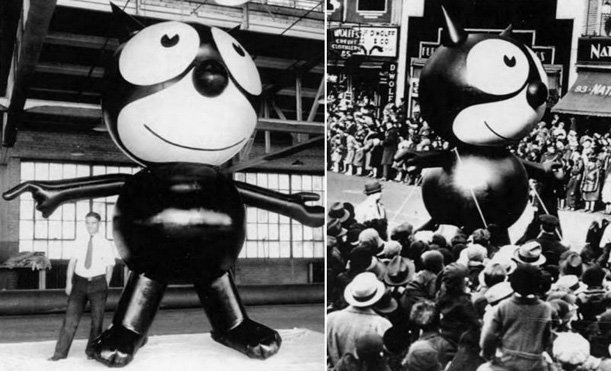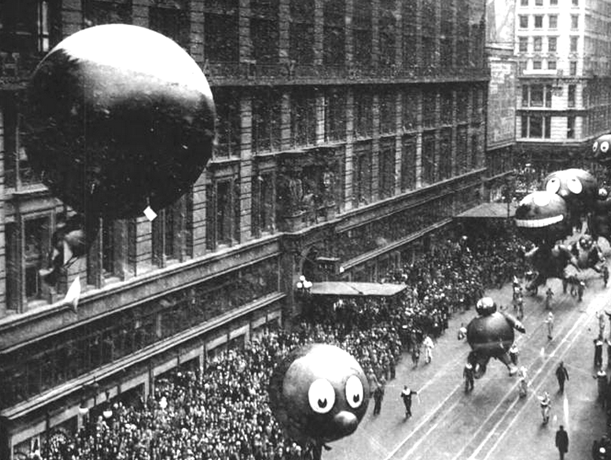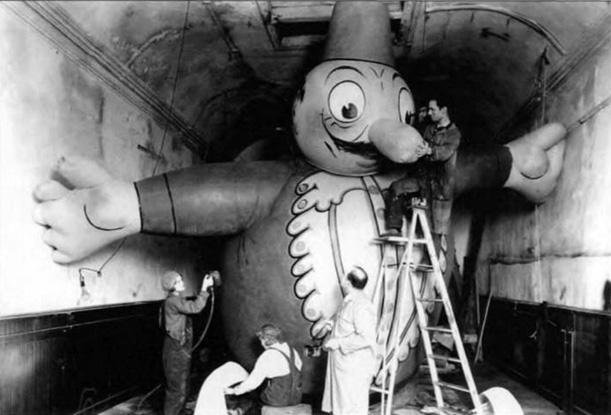The Puppeteer Who Brought Balloons to the Thanksgiving Day Parade
A Thursday morning tradition came with strings attached
/https://tf-cmsv2-smithsonianmag-media.s3.amazonaws.com/filer/20131127122037macys-thanksgiving-day-parade-balloons.jpg)
The first Macy’s Thanksgiving Day parade (then known as the Macy’s Christmas Parade) was held in 1924 and culminated in front of Macy’s department store in New York City, where the elaborate holiday window displays were unveiled. Thousands gathered to see the displays, which were designed by Anthony Frederick Sarg, a noted puppeteer and theatrical designer. Sarg was also the artistic director / mastermind of the parade and, during the fourth annual Macy’s Christmas Parade in 1927, he introduced the enormous inflatable cartoons and caricatures that would become almost synonymous with the annual holiday tradition.

The 1927 Felix the Cat balloon. One of the first balloons to be carried down Broadway on Thanksgiving Day. (image: Macy’s Thanksgiving Day Parade)
Creativity was in Sarg’s genes. Born in Germany, his father was an artist, his grandfather a wood-carver, and his grandmother was a painter who gave the young Sarg a collection of mechanical toys that may have inspired the imagination of the burgeoning designer. But it wasn’t until he saw a performance by famed puppeteer Thomas Holden, who essentially invented the marionette, that Sarg found his calling. He began experimenting with puppet designs and stagings around 1917, eventually earning renown for his particularly sophisticated puppet shows that included performances of Faust and Don Quixote. After World War I, Sarg moved to New York City and quickly gained a reputation as a practical joker, the life of the party and a tireless worker. In his various ventures, the designer, inventor and illustrator worked on cartoons, children’s books, mechanical toys, advertising and of course, window displays and balloons.
These first parade balloons were filled with oxygen not helium, and were propped up by teams of puppeteers – usually just Macy’s employees drafted into parade service. These balloons, such as 1920s biggest cartoon star Felix the Cat (above), were cruder and smaller than today’s Godzilla-like monsters but still charmed and captivated the throngs of onlookers who came to ring in the holiday season.
Other early balloons included a 20-foot-long elephant, a 60-foot-long tiger and an enormous hummingbird. In 1928, the parade culminated with a release of the now-helium-filled balloons into the skies above the city. The stunt was a crowd-pleaser and the following year, the balloons were designed with release valves to make their ascent easier and Macy’s offered rewards for their capture and return. The tradition that continued until 1932, when a daredevil pilot thought it would be fun to capture the balloons with her biplane and nearly crashed when the rubberized canvas wrapped itself around the plane’s wing.

The balloon ascent at the end of the 1930 Parade (Image: Ballard Institute of Puppetry, University of Connecticut via Macy’s Thanksgiving Day Parade)
The rubberized silk balloons were produced by the Goodyear Tire & Rubber Company in Akron, Ohio, and their archives at the University of Akron include some amazing pictures of these early behemoths.
Anthony Sarg (center) and puppeteers touch up a parade balloon in 1929. (image: Macy’s Thanksgiving Day Parade)
/https://tf-cmsv2-smithsonianmag-media.s3.amazonaws.com/accounts/headshot/Jimmy-Stamp-240.jpg)

/https://tf-cmsv2-smithsonianmag-media.s3.amazonaws.com/accounts/headshot/Jimmy-Stamp-240.jpg)